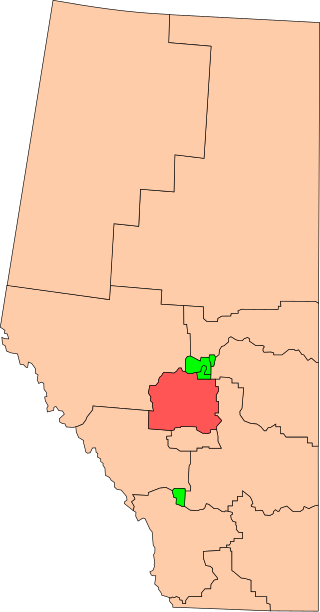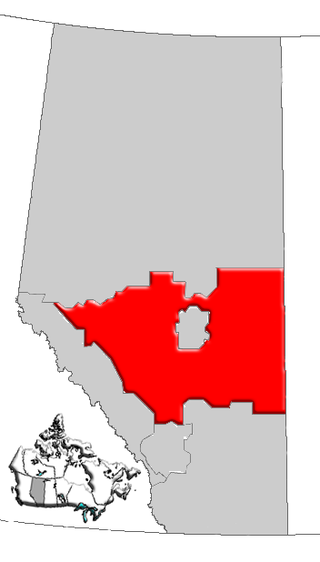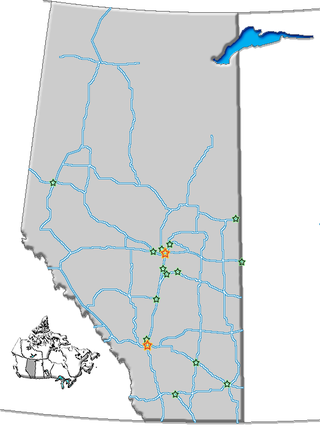
Wetaskiwin is a city in the province of Alberta, Canada. The city is located 70 kilometres (43 mi) south of the provincial capital of Edmonton. The city name comes from the Cree word wītaskiwinihk, meaning "the hills where peace was made".

Wetaskiwin was a federal electoral district in Alberta, Canada, that was represented in the House of Commons of Canada from 1925 to 2015.

The Reynolds-Alberta Museum is an agricultural, industrial, and transportation museum in Wetaskiwin, Alberta, Canada. The museum is situated on an 89-hectare (220-acre) property containing the main museum building, an aviation display hangar, and its storage facility.

Red Deer was a federal electoral district in Alberta, Canada, that was represented in the House of Commons of Canada from 1908 to 2015.

Harcourt House Artist Run Centre is one of four artist-run centres in Edmonton, Alberta, Canada. The centre delivers a host of services to both artists and the community, and acts as an alternative site for the presentation, distribution and promotion of contemporary art.

The Alberta Legislature Building is located in Edmonton and is the meeting place of the Legislative Assembly of Alberta and the Executive Council of Alberta. It is often shortened to "the Ledge".

Government House is the former official residence of the lieutenant governors of Alberta. Located in Edmonton's Glenora neighbourhood, since 1964 the restored and repurposed building has been used by the Alberta provincial government for ceremonial events, conferences, and some official meetings of the caucus.

The Halifax Court House is a historic building in downtown Halifax, Nova Scotia. Its main section was completed in 1863, with the east wing, built in 1930, being the newest portion. The Italian renaissance style building was designed by William Thomas, a Toronto architect who created prominent structures across Canada, and built by George Lang.

The Alberta Aviation Museum is an aviation museum located in Edmonton, Alberta, Canada. The museum is located on-site at the former Edmonton City Centre Airport on the southwest corner of the field.

Rutherford House is a historic building and museum in the Strathcona area of Edmonton, Alberta, Canada. The structure was the home of the first Premier of Alberta, Alexander Cameron Rutherford, from 1911 to 1941, and has subsequently been designated as an Alberta provincial historic site.

Central Alberta is a region located in the Canadian province of Alberta.

Provincial historic sites of Alberta are museums and historic sites run by the Government of Alberta.
Heritage buildings in Edmonton, as elsewhere in Canada, may be designated by any of the three levels of government: the Government of Canada, the Government of Alberta, or the City of Edmonton.

The Monroe Avenue Commercial Buildings, also known as the Monroe Block, is a historic district located along a block-and-a-half stretch at 16-118 Monroe Avenue in Detroit, Michigan, just off Woodward Avenue at the northern end of Campus Martius. The district was designated a Michigan State Historic Site in 1974 and listed on the National Register of Historic Places in 1975. The thirteen original buildings were built between 1852 and 1911 and ranged from two to five stories in height. The National Theatre, built in 1911, was the oldest surviving theatre in Detroit, a part of the city's original theatre district of the late 19th century, and the sole surviving structure from the original Monroe Avenue Commercial Buildings historic period.

Lougheed House, or as it was originally known Beaulieu, is a National Historic Site located in the Beltline district of Calgary, Alberta. Originally constructed in 1891 as a home for Senator James Alexander Lougheed KCMG PC KC and his wife Isabella Clarke Hardisty, the structure has since become an iconic heritage building in Calgary. Lougheed House is operated by Lougheed House Conservation Society, an independent, non-profit society devoted to the restoration and public enjoyment of the historic house and its Gardens.

The Land Titles Building was a federal government office built in Edmonton in 1893. It later became the Victoria Armoury, and was used by three Edmonton regiments. It is "likely the oldest existing Land Titles Office in Alberta, one of the oldest extant buildings in the province, and certainly the first purpose-built registry office".

The Jasper Park Information Centre National Historic Site, located in Jasper National Park, Alberta, Canada, is the primary visitor contact centre for visitors to the park. Sited in the Jasper townsite, it was built as the park administration building in 1913-1914, and became the visitor contact centre in 1972. It is located in Athabasca Park, which is not included in the National Historic Site designation.

Calgary City Hall, is the seat of government for Calgary City Council, located in the city's downtown core of Calgary, Alberta, Canada. The historic building completed in 1911 serves as the offices for Calgary City Council, consisting of the office of the Mayor, fourteen Councillors and municipal Clerk. Calgary City Hall originally housed the municipal council and portions of administration from its completion in 1911 until the construction of the Calgary Municipal Building adjacent to Old City Hall in 1985, which currently houses the offices of 2,000 civic administrators.

McKay Avenue School is a former school and historic site in Edmonton, Alberta, Canada. The site is a Provincial and Municipal Historic Resource, and home to the Edmonton Public School Board's archives and museum.

The Duggan House, officially the J. J. Duggan Residence, is a brick building in Edmonton, Alberta, Canada, that is a both a Provincial Historic Resource and a Municipal Historic Resource. It was listed on the Canadian Register of Historic Places in 2008. Located in Edmonton's Old Strathcona district, it was built in 1907 for John Joseph Duggan, two-time mayor of the then city of Strathcona, and a longtime Edmonton businessman. Duggan lived there with his family for 25 years, and then the house was sold to the city and slated for demolition.


















